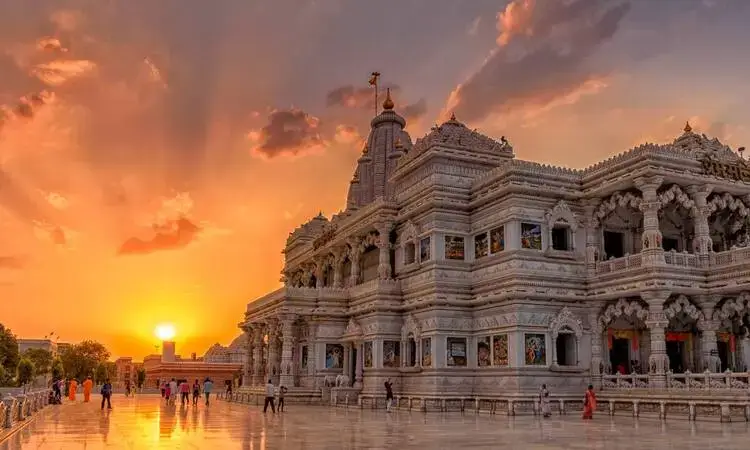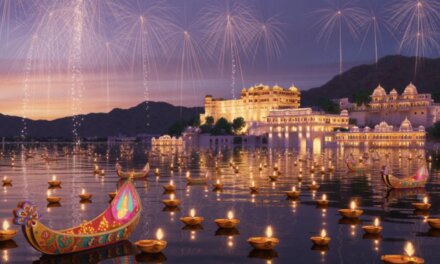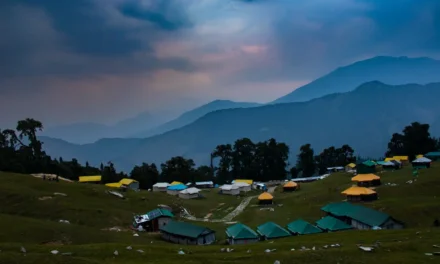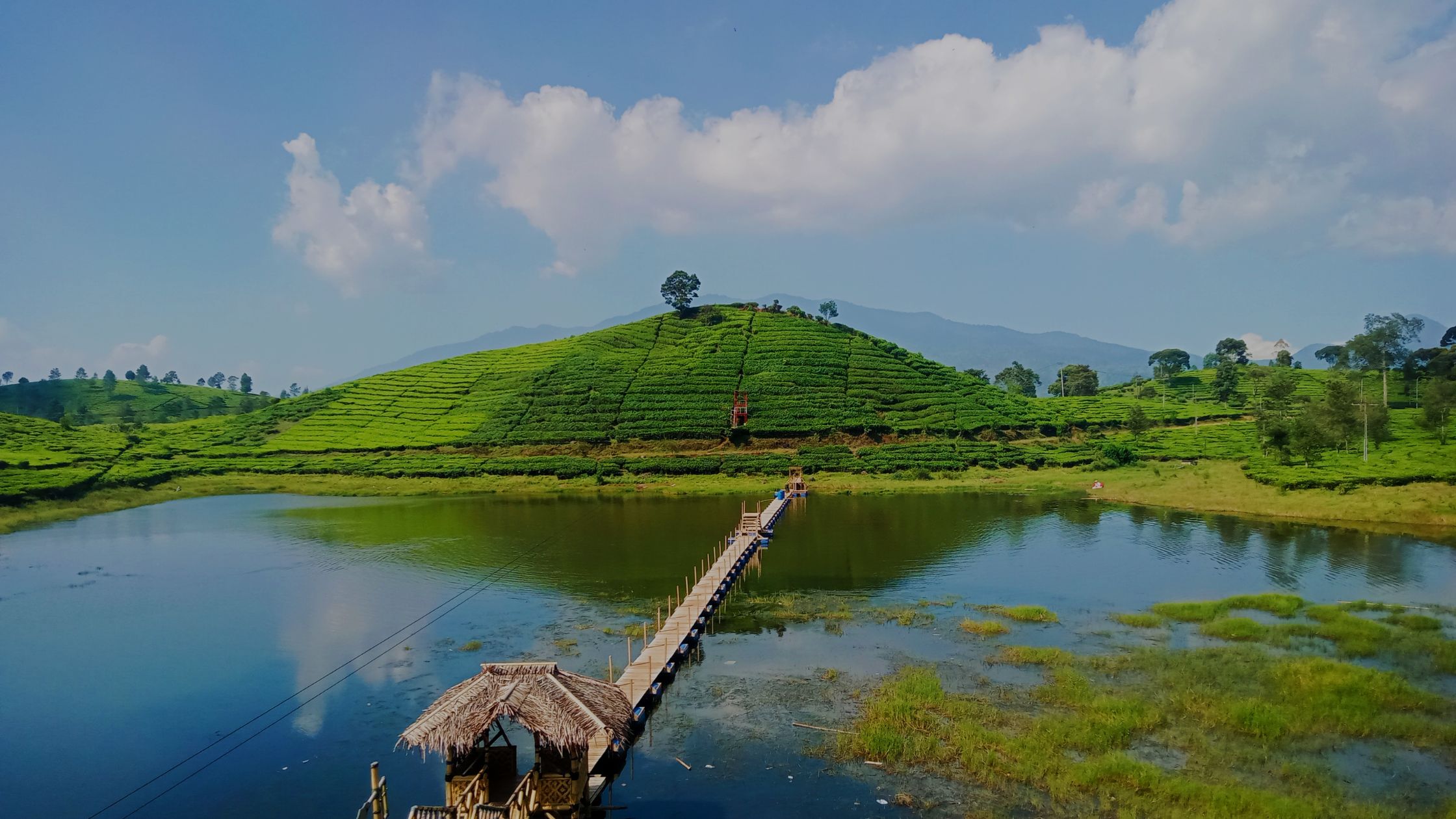
Vrindavan Unveiled: A Mystical Journey Through Time and Spirituality

Welcome to a special exploration into the wonderful world of Vrindavan, a place filled with spirituality and history. Vrindavan is often known as the favorite place of Lord Krishna, where ancient temples and cobblestone streets hold the secrets of divine love and beauty.
In our gathering today, we’ll travel through the sacred places where legendary stories unfold. The air still carries the sweet tunes of Krishna’s flute, and the love between Radha and Krishna fills every corner with a special kind of fragrance.
Our journey isn’t just about the past; it’s about understanding the deep spiritual meaning of Vrindavan. This place has influenced seekers and pilgrims for centuries, and we’ll explore why.
But our adventure isn’t just a history lesson; it’s a chance to connect with ourselves and discover timeless truths. As we soak in the mystique of Vrindavan, let’s open our hearts and minds to the wisdom it has to offer. Feel the calm in its sacred groves and discover enlightenment in its ancient streets.
So, my dear friends, let’s start this journey together. We’ll uncover the mysteries of Vrindavan and let its divine essence brighten our souls.
History And Culture Of Vrindavan
Vrindavan, a town in Uttar Pradesh, India, is famous for its history connected to Lord Krishna. It’s believed to be where Krishna spent his childhood, and it attracts many pilgrims and travelers.
Historical Background:
- Mythical Beginnings: Vrindavan has a long history linked to Hindu mythology. It was a lush forest where Krishna played with his friends and performed divine acts. Archaeological findings show settlements dating back to 6th century BCE.
- Medieval Era: In the 16th and 17th centuries, Vrindavan became a significant pilgrimage site. The Mughal emperor Akbar allowed the construction of many temples during a treaty with Hindu king Man Singh.
- Present Day: Vrindavan is now a bustling spiritual hub with over 5,000 unique temples. However, it faces challenges balancing its religious identity with modern development and environmental concerns.
Cultural Highlights:
- Krishna Worship: Vrindavan’s culture is deeply rooted in Vaishnavism, a Hindu tradition that reveres Krishna as the supreme deity. The town echoes with devotional songs and temple rituals.
- Festivals: Vrindavan hosts lively festivals, including Janmashtami, celebrating Krishna’s birthday, and Holi, the festival of colors, with special significance related to Krishna’s playful nature.
- Music and Dance: Kirtans (devotional hymns) and traditional dances like Raslila, depicting Krishna’s divine dance, are integral to Vrindavan’s cultural scene.
- Arts and Crafts: Local artisans create beautiful artworks inspired by Krishna’s life. Paintings, sculptures, and handicrafts made from various materials reflect the town’s artistic heritage.
- Language and Cuisine: The local language is Braj Bhasha, a sweet dialect of Hindi. Vrindavan’s cuisine is vegetarian, offering dishes like dal makhani, kachoris, and pedas.
Also Read: From Dreams to Reality: Ram Mandir Ayodhya Nears its Grand Opening
Famous Things To Do In Vrindavan
Vrindavan, in Uttar Pradesh, India, is a special town for Hindus because it’s believed to be where Lord Krishna spent his childhood. Here are some cool things to do In Vrindavan:
- Visit Lots of Temples: Vrindavan has over 5,000 temples! Many are dedicated to Lord Krishna and Radha. Some famous ones are Banke Bihari Temple, Prem Mandir, Radha Raman Temple, and ISKCON Temple.
- Watch Aarti: Aarti is a beautiful Hindu ritual where light is offered to a deity. You can see this at Vrindavan’s temples, and it’s a moving experience.
- Boat Ride on Yamuna River: The Yamuna River is special for Hindus. Taking a boat ride there is a popular activity in Vrindavan.
- Explore Seva Kunj and Nidhivan: These are gardens believed to be where Lord Krishna and Radha used to meet.
- Shop for Souvenirs: Vrindavan is a great place to buy souvenirs like religious items, clothes, and handicrafts.
- Enjoy Local Food: Vrindavan is known for tasty vegetarian food. Try local favorites like kachoris, samosas, jalebis, Pedas, Makhan Mishri, Gulab Jamuns, Malpua, Aloo Tikki, Chaat and Lassi.
- Join Festivals: Here are some of the most famous festivals of Vrindavan live Janmashtami, Lathmar Holi, Brahmotsav, Jhulanotsav and Annakut. Going to one is a fantastic way to experience the town’s culture and traditions.
Famous Temples In Vrindavan
Here are some of the most famous temples in Vrindavan:
1. Prem Mandir
Prem Mandir, commonly known as the Temple of Divine Love, stands as an exquisite Hindu temple in Vrindavan, Uttar Pradesh, India. Crafted entirely from white Italian marble, this sacred place is dedicated to the revered deities Radha Krishna and Sita Ram.
The visionary behind this masterpiece is Jagadguru Kripalu Maharaj, who dedicated over 11 years to its construction, culminating in its inauguration in 2012. The temple complex, sprawling across 54 acres, encompasses various structures like a museum, library, and guest house.
The main temple, a two-story marvel, boasts dimensions of 125 feet in height, 190 feet in length, and 128 feet in width. Its distinguishing features include intricate carvings illustrating the lives of Radha Krishna and Sita Ram. Within the temple, visitors can find a collection of statues and paintings portraying the divine deities.
- Temple timings: The temple is open from 5:30 am to 12:00 pm and 4:30 pm to 8:30 pm.
2. Banke Bihari Mandir
The Banke Bihari Mandir is a Hindu temple dedicated to Banke Bihari, a combination of Radha and Krishna. It’s located in Vrindavan, a town in Uttar Pradesh, India. People visit it because it’s sacred and famous.
The Banke Bihari idol was discovered by Swami Haridas in Nidhivan, a grove near Vrindavan. Originally, people worshipped it there, but it was later moved to the current temple, built around 1864.
This temple is small, with a simple white front. Inside, you’ll find colorful paintings and murals. The Banke Bihari idol wears fancy clothes and jewelry and is decorated with flowers. Many devotees like you come here every year.
Also Read: Maa Chandrika Devi Temple – A Place of Sacred Wonder in Lucknow!
3. Iskcon Temple
ISKCON Vrindavan, also known as Sri Sri Krishna Balaram Mandir, stands as a significant ISKCON temple in Vrindavan, Uttar Pradesh, India. Unveiled in 1975, it’s a homage to Hindu deities Krishna and Balarama. The temple, crafted from white marble adorned with detailed carvings, owes its existence to the generous land donation by then-Prime Minister Indira Gandhi. This sacred site encompasses not only the temple itself but also a guest house, restaurant, and library.
Visitors of all faiths are welcome to partake in the religious services offered at ISKCON Vrindavan, ranging from lectures to kirtan (chanting) and aarti (lamp worship). The temple is more than a spiritual haven; it hosts diverse festivals throughout the year, with Janmashtami, celebrating Krishna’s birth, being a major highlight.
This revered pilgrimage destination attracts people globally, emphasizing its inclusive nature by opening its doors to individuals of all faiths.
- Temple timings: The temple is open from 4:30 am to 9:00 pm.
4. Radha Vallabh Mandir
The Radha Vallabh Temple stands proudly in the sacred town of Vrindavan, India, dedicated to the revered Hindu deities Radha and Krishna. Its rich history dates back to the 16th century when it was constructed by the esteemed saint, Hith Harivansha Mahaprabhu. Esteemed for its architectural beauty, the temple’s design seamlessly blends elements of Mughal and Rajput styles, showcasing a captivating fusion of cultural influences.
At the heart of the temple lies a magnificent black marble statue of Krishna, believed by devotees to be self-manifested—an embodiment of divine presence. Beyond Krishna, the temple complex houses a pantheon of other deities, including Radha, Lalita, and Vishakha, each revered in their own right within the Radha Vallabh Sampradaya tradition.
Through the ages, the Radha Vallabh Temple has remained a beacon of spiritual devotion, drawing pilgrims and visitors from far and wide to experience its sacred ambiance and pay homage to the eternal love between Radha and Krishna.
- Temple timings: The temple is open from 7:00 am to 12:00 pm and 6:30 pm to 9:00 pm
5. The Radha Raman Mandir
The Radha Raman Temple in Vrindavan, India, is a Hindu temple dedicated to Lord Krishna, specifically known as Radha Ramana, which means “Srimati Radha’s sweetheart.” It’s one of the seven highly respected temples in Vrindavan and holds special significance for Gaudiya Vaishnavism followers.
Built in 1542 by Gopala Bhatta Goswami, one of the six Goswamis of Vrindavan, the temple has an interesting story. Legend has it that Lord Krishna appeared in Gopala Bhatta Goswami’s dream, instructing him to go to Nepal and retrieve a sacred black stone called Shaligram Shila. This stone is believed to be a form of Lord Krishna. When Gopala Bhatta Goswami dipped his water pot in the Kali Gandaki River in Nepal, several Shaligram Shilas mysteriously appeared in the pot. He brought these stones back to Vrindavan and installed one of them in the Radha Raman Temple.
The temple showcases beautiful Hindu architecture, featuring a white marble exterior and an intricately decorated interior. Inside the main shrine, you’ll find the Shaligram Shila of Radha Ramana, adorned with colorful garments and jewels. The temple also houses other deities, including various forms of Radha and Krishna, as well as the Gurus of the Gaudiya Vaishnava lineage.
- Temple timings: The temple is open from 5:00 am to 12:30 pm and 4:30 pm to 9:00 pm.
6. Shri Ranganatha Mandir
The Shri Ranganatha Temple, also called Rangji Temple, is a grand Hindu temple in Vrindavan, Uttar Pradesh, India. It’s dedicated to Lord Vishnu and Lakshmi, making it an essential Vaishnava temple in North India.
Built in the 19th century by Seth Radha Krishna and Seth Govindadasa from Chennai, the temple showcases Dravidian-style architecture. It’s renowned for its tall gopurams (entrance towers), intricate carvings, and lovely gardens.
At the heart of the temple is the main deity, Sri Ranganatha, a reclining form of Lord Vishnu, resting on the coils of Shesh Nag, a serpent deity. The temple also houses idols of Sita, Rama, Lakshmana, Lord Narasimha, Ramanujacharya, and Venugopala.
- Temple timings: The temple is open from 8:00 am to 12:00 pm and 3:00 pm to 7:30 pm.
7. Katyayani Peeth Mandir
The Katyayani Peeth Temple is a Hindu temple in Vrindavan, Uttar Pradesh, India, dedicated to the goddess Katyayani, a form of Parvati. It was built in 1923 by Yogiraj Swami Keshavanand Brahmchari, who claimed to have been instructed by Katyayani Devi in a vision. The temple follows traditional Hindu architecture with a tower and hall. Inside, there’s a black stone idol of Katyayani Devi.
People visit the Katyayani Peeth Temple as it’s one of the 51 Shakti Peethas linked to the goddess Sati. Pilgrims, especially those seeking blessings for marriage, children, and health, come from all over India. The temple conducts various religious ceremonies like pujas and abhishekams for devotees.
8. Sri Govind Devji Mandir
The Sri Govind Devji Temple in Vrindavan, India, is a significant Hindu temple dedicated to Lord Krishna in his Govind Dev Ji form. It’s highly revered by Vaishnavites and considered one of Vrindavan’s holiest places.
Built in the 16th century by Raja Man Singh I, the temple was initially a seven-story structure made of red sandstone. Unfortunately, during Aurangzeb’s reign, the top four floors were destroyed, leaving only the current three stories.
The temple is known for its beautiful architecture, with detailed carvings and a large central hall. Inside the sanctum sanctorum, you’ll find the sacred image of Govind Dev Ji, one of the most important Krishna idols in existence.
- Temple timings: The temple is open from 4.30 am to 12.30 pm and 5.30 pm to 9.00 pm
9. Shri Radha Gokulananda Mandir
The Shri Radha Gokulananda Temple stands as a venerable Hindu sanctuary nestled in the heart of Vrindavan, Uttar Pradesh, India. This sacred site, steeped in history, is dedicated to the worship of Radha and Krishna, making it a cherished pilgrimage destination for devotees devoted to these divine deities.
Constructed during the 16th century, the temple’s architectural splendor is attributed to the revered Gaudiya Vaishnava saint, Viswanath Chakravarti. Within its hallowed halls, a pantheon of deities is enshrined, including Radha-Vinoda, Vijaya Govinda, Radha Gokulananda, and Caitanya Mahaprabhu. Each statue holds a unique significance in the hearts of the temple’s visitors.
The Shri Radha Gokulananda Temple not only captivates worshippers with its spiritual significance but also mesmerizes them with its exquisite architecture. The temple’s aesthetic beauty and the tranquil ambiance create a serene atmosphere, inviting devotees and visitors alike to immerse themselves in the divine energy that permeates this ancient place of worship.
- Timings: The temple is open from 5:00 am to 12:00 pm and 4:00 pm to 8:00 pm.
10 Shahji Mandir
The Shahji Temple, also known as the Temple with Crooked Pillars, is a Hindu temple in Vrindavan, Uttar Pradesh, India, dedicated to Lord Krishna and Radha. It was constructed in 1876 by two Lucknow-based brothers, Shah Kundan Lal and Shah Phundan Lal. The temple is famous for its special design, featuring 12 beautiful spiral columns made of Italian marble, each 15 feet tall and 35 inches in diameter.
The main deity in the temple is Chhote Radha Raman, a small idol of Radha and Krishna. Additionally, the temple houses idols of Lalit Kishori and Lalit Mohini Sevya Thakur Thakurani. The temple complex includes a large hall called Basanti Kamra, adorned with Belgian glass chandeliers and intricate paintings. This hall is only opened twice a year, on Basant Panchami and Jhulan Yatra occasions.
- Timings: The temple is open to visitors all year round, from 8 AM to 11 AM and from 5.30 PM to 7.30 PM.
11. Gopeshwar Mahadev Mandir
The Gopeshwar Mahadev Temple in Vrindavan is a very old and special temple. It honors Lord Shiva, who is worshipped in the form of Gopeshwar, a lingam that looks like a Gopi (female devotee). This unique temple is located near the Yamuna River in the Vamshivat area of Vrindavan.
Legend has it that the Gopeshwar lingam was set up by Vrajanabha, who was Lord Krishna’s great-grandson. The story goes that Lord Shiva transformed into a Gopi to join the Raas Leela, a divine dance performed by Lord Krishna with his Gopis.
The Gopeshwar Mahadev Temple is a peaceful and beautiful place. Although the temple complex is small, it has a serene and spiritual atmosphere. Inside the main shrine, you’ll find the Gopeshwar lingam adorned with flowers and offerings. Additionally, there are smaller shrines dedicated to other deities like Hanuman and Ganesha.
- Timings: 6:00 AM to 10:00 AM and 5:00 PM to 9:00 PM
12. Nidhivan Mandir
Nidhivan is a special forest in Vrindavan, Uttar Pradesh, India, considered very holy in Hinduism. People believe it’s where Lord Krishna and Radha had their divine dance, the Rasa lila. The forest is filled with Tulsi plants, sacred to Vishnu, thought to be the gopis who danced with Krishna. Legend says the gopis turned into trees after the dance, and these trees move and sway at night, like they’re still dancing with Krishna. People say you can hear the sound of anklets if you listen closely.
In the middle of Nidhivan, there’s a simple temple called Nidhivan Temple, dedicated to Radha and Krishna. Inside, there are statues of these deities. The temple closes at night because it’s believed that Radha and Krishna come to dance in the grove.
- The temple is open from 5:00 am to 7:00 pm.
13. Priyakant Ju Mandir
The Priyakant Ju Temple is a new Hindu temple in Vrindavan, Uttar Pradesh, India, dedicated to Radha Krishna. It was finished in 2016 and is admired for its beautiful design and detailed carvings.
The temple looks like a lotus flower and is made of white marble. It has seven spires representing Vrindavan’s seven hills. The main gods worshipped in the temple are Radha Krishna, portrayed as Priya Ji and Kant Ju.
- The temple is open from 6:00 AM to 12:00 PM and 4:00 PM to 9:00 PM.
14. Jaipur Mandir
The Jaipur Temple, also called Kishor Gopal Mandir, is a beautiful Hindu temple in Vrindavan, Uttar Pradesh, India. It was built by Maharaja Sawai Madho Singh II of Jaipur in the early 1900s and took 30 years to complete. They used red sandstone from Rajasthan for the construction. This temple is dedicated to Lord Krishna and Radha, with main deities like Radha Madhava, Ananda-bihari, and Hansa-gopala.
The Jaipur Temple is famous for its detailed carvings and sculptures. It has a big courtyard and lovely gardens. Apart from the main temple, there are also smaller shrines and buildings in the complex.
- The temple is open from 5:00 AM to 12:00 PM and from 4:00 PM to 9:00 PM.
15. Shri Gopinath Mandir
The Shri Gopinath Temple in Vrindavan, India, is a really old and famous temple dedicated to Lord Krishna, also known as Gopinath, meaning “Lord of the Gopis.” It’s believed to be more than 5,000 years old, and the current building goes back to the 16th century.
The temple is a stunning example of Hindu architecture, with detailed carvings and colorful paintings. Inside, the main shrine holds a black marble idol of Lord Krishna, dressed in traditional clothing and decorated with jewelry. There are also idols of Radha, Krishna’s partner, and Lalita, one of his gopis (female devotees).
People from all over India come to this temple for pilgrimage. They pray to Lord Krishna for blessings. The temple is also a popular spot for tourists who are attracted to its beauty and the spiritual atmosphere.
- Opening hours: The temple is open from 5:00 am to 12:30 pm and from 4:00 pm to 9:00 pm.
Best Hotel In Vrindavan
Choosing the best hotel in Vrindavan depends on your needs. Here are some hotels in Vrindavan that are close to the famous temples:
- The VrindWoods Hotel: Laid-back rooms in an unpretentious hotel featuring an outdoor pool, Wi-Fi, and dining. It is located near Prem Mandir and Banke Bihari Temple.
- Anandam Clarks Inn Suites: Relaxed hotel offering a restaurant, a 9D cinema & event space, plus a spa, a gym & an outdoor pool. It is located near ISKCON Temple and Prem Mandir.
- Nidhivan Sarovar Portico: Modern hotel with a spa, an outdoor pool, and multiple dining options. It is located near ISKCON Temple and Banke Bihari Temple.
- Hare Krishna Orchid: Simple rooms in a laid-back hotel offering an outdoor pool, a sauna & a gym, plus dining & a garden. It is located near Prem Mandir.
- Hotel Best Western Vrindavan: Casual rooms & suites in a laid-back hotel offering a banquet hall & a restaurant. It is located near ISKCON Temple and Banke Bihari Temple.
Best Time To Visit Vrindavan
The best time to visit Vrindavan depends on what you’re looking for.
- Best Time (October to March): This is when many people go because the weather is nice – not too hot or cold. You can explore temples and sights comfortably, but it can be crowded and expensive.
- Okay Time (April to June): It gets hot during these months, up to 45°C. If you’re on a budget, it’s a good time because there are fewer people and hotels might be cheaper. But it’s not great for outdoor activities.
- Rainy Time (July to September): This is when it rains a lot, but it cools things down. If you don’t mind the rain, it’s a beautiful time with lush greenery.
Distance Of Vrindavan From Your Home
| Distance Of Vrindavan | Distance |
|---|---|
| Mathura to Vrindavan distance | 14.6 km |
| Haridwar to Vrindavan distance | 338.2 km |
| Kanpur to Vrindavan distance | 365.1 km |
| Noida to Vrindavan distance | 139.5 km |
| Govardhan to Vrindavan distance | 24.0 km |
| Gokul to Vrindavan distance | 25.6 km |
| Ayodhya to Vrindavan distance | 532.4 km |
| Jaipur to Vrindavan distance | 232.9 km |
| Delhi to Vrindavan distance | 160.7 km |
| Agra to Vrindavan distance | 84.0 km |
| Lucknow to Vrindavan distance | 399.0 km |
| Varanasi to vrindavan distance | 709.2 km |
| Gurgaon to Vrindavan distance | 133.3 km |
| Chandigarh to Vrindavan distance | 423.3 km |
| Aligarh to Vrindavan distance | 67.5 km |
| Meerut to Vrindavan distance | 201.5 km |
| Amritsar to Vrindavan distance | 609.0 km |
| Kota to Vrindavan distance | 440.6 km |
| Ujjain to Vrindavan distance | 652.5 km |
| Mumbai to Vrindavan distance | 1,271.8 km |
| kolkata to Vrindavan distance | 1,407.2 km |
| Ahmedabad to Vrindavan distance | 877.1 km |
| Ghaziabad to Vrindavan distance | 168.2 km |
| Indore to Vrindavan distance | 689.8 km |
| Gwalior to Vrindavan distance | 185.2 km |
| Faridabad to Vrindavan distance | 111.9 km |
| Barsana to Vrindavan distance | 43.3 km |
Conclusion
In conclusion, Vrindavan stands as a timeless sanctuary where spirituality intertwines with history, offering visitors a profound journey into the heart of Hindu mythology and devotion. From its mythical beginnings as the playground of Lord Krishna to its present-day bustling spiritual hub, Vrindavan continues to captivate pilgrims and travelers alike with its rich cultural tapestry.
The town’s plethora of temples, each with its own unique significance and architectural splendor, beckons devotees to immerse themselves in the divine presence of Radha and Krishna. Whether it’s the grandeur of Prem Mandir or the simplicity of Nidhivan Temple, each sacred site evokes a sense of reverence and awe.
Beyond temple visits, Vrindavan offers a vibrant tapestry of cultural experiences, from participating in traditional festivals like Janmashtami and Holi to indulging in the delectable vegetarian cuisine that reflects the town’s culinary heritage.
However, amidst its spiritual allure, Vrindavan grapples with modern challenges, balancing its religious identity with the demands of development and environmental preservation. As visitors embark on their journey through this mystical town, they are invited not only to witness its history and culture but also to reflect on the timeless truths and spiritual wisdom it embodies.
In essence, Vrindavan is not merely a destination; it is a sacred pilgrimage, a profound exploration of the divine, and a timeless sanctuary where the soul finds solace amidst the echoes of eternal love and devotion.
Are there any specific guidelines for visiting temples in Vrindavan?
Respectful attire and behavior are appreciated. Photography might be restricted in some temples, so it’s essential to check and abide by the rules.
Are there any hidden gems in Vrindavan that are less crowded?
Yes, exploring the lesser-known temples and ghats can offer a more intimate and serene experience away from the bustling crowds.
How can I contribute to Vrindavan’s preservation efforts?
Participate in local community initiatives, support eco-friendly practices, and contribute to responsible tourism.
























